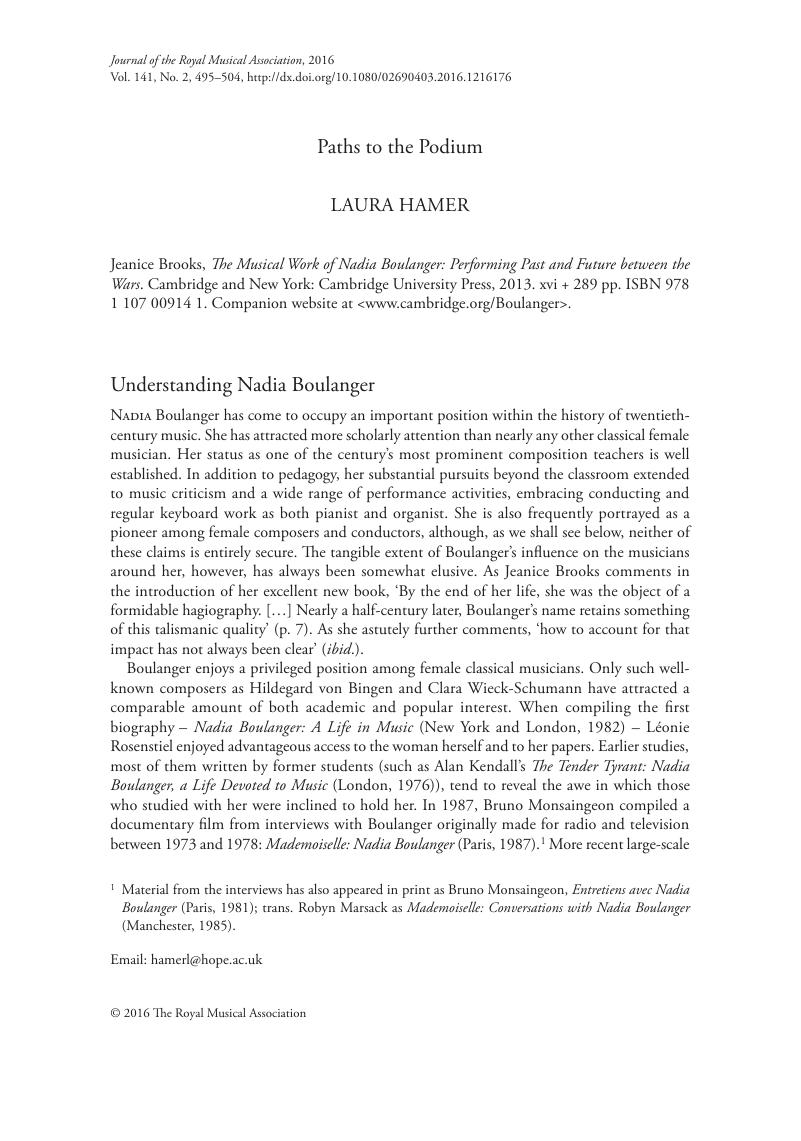No CrossRef data available.
Article contents
Abstract

- Type
- Review Articles
- Information
- Copyright
- Copyright © 2016 The Royal Musical Association
References
1 Material from the interviews has also appeared in print as Bruno Monsaingeon, Entretiens avec Nadia Boulanger (Paris, 1981); trans. Robyn Marsack as Mademoiselle: Conversations with Nadia Boulanger (Manchester, 1985).
2 In offering the above (brief) overview of the literature on Boulanger, I have concentrated on large-scale studies, and those in which she is the central focus. Other studies include Jeanice Brooks, ‘Nadia Boulanger and the Salon of the Princesse de Polignac’, Journal of the American Musicological Society, 46 (1993), 415–68; Brooks,‘“Noble et grande servante de la musique”: Telling the Story of Nadia Boulanger's Conducting Career’, Journal of Musicology, 14 (1996), 92–116; Caroline Potter, ‘Nadia and Lili Boulanger: Sister Composers’, Musical Quarterly, 83 (1999), 536–56; and studies in which she is not the main focus, such as Annegret Fauser, ‘“La guerre en dentelles”: Women and the “Prix de Rome” in French Cultural Politics’, Journal of the American Musicological Society, 51 (1998), 83–129; Kimberly Francis, ‘A Dialogue Begins: Nadia Boulanger, Igor Stravinsky, and the Symphonie de psaumes, 1930–1932’, Women and Music, 14 (2010), 22–44; and Francis, ‘A Most Unsuccessful Project: Nadia Boulanger, Igor Stravinsky, and the Symphony in C, 1939–45’, Musical Quarterly, 94 (2011), 234–70.
3 For an account of Nadia Boulanger's engagement with the Prix de Rome competition, see Fauser, ‘“La guerre en dentelles”’.
4 Caroline Potter, Nadia and Lili Boulanger (Aldershot, 2006), xi.
5 See Léonie Rosenstiel, Nadia Boulanger: A Life in Music (New York and London, 1982), esp. Chapters IV–VII.
6 Potter, Nadia and Lili Boulanger, xi.
7 See Brooks, ‘“Noble et grande servante de la musique”’.
8 Louise Farrenc had been the first woman to teach piano at the Paris Conservatoire during the nineteenth century; however, during her years there the distinction between ‘preparatory’ and ‘advanced’ classes had not existed, and her teaching duties had been confined to female students. See Bea Friedland, ‘Louise Farrenc (1804–1875): Composer, Performer, Scholar’, Musical Quarterly, 9 (1974), 157–74.
9 For an account of Long's career, see Cecilia Dunoyer, Marguerite Long: A Life in French Music (Bloomington and Indianapolis, IN, 1993).
10 Richard Taruskin, ‘The Pastness of the Present and the Presence of the Past’, Authenticity and Early Music: A Symposium, ed. Nicholas Kenyon (Oxford, 1988), 137–207 (p. 131).
11 Brooks adapts the term ‘collection museum’ from Anne Higonnet; see Higonnet, A Museum of One's Own: Private Collecting, Public Gift (Pittsburgh, PA, 2009), xiii–xiv.
12 Alan Kendall, The Tender Tyrant: Nadia Boulanger, a Life Devoted to Music (London, 1976), 105.
13 For information on the all-women orchestras which flourished in the US in the first half of the twentieth century, see Carol Neuls-Bates, ‘Women Orchestras in the United States, 1925–45’, Women Making Music: The Western Art Tradition, 1150–1950, ed. Jane Bowers and Judith Tick (Urbana and Chicago, IL, 1986), 349–69.
14 In the field of jazz, Josephine Bradley, who established her own Ballroom Orchestra in 1935, provides a rare example of a woman leading a male dance band.
15 For information on Armande de Polignac, see Florence Launay, Les compositrices en France au XIXe siècle (Paris, 2006); Launay, ‘Armande de Polignac’, Compositrices au XXème siècle, ed. Association Femmes et Musique (Paris, 2007), 177–89; and Laura Hamer, ‘Armande de Polignac: An Aristocratic compositrice in fin-de-siècle Paris’, Women in the Arts in the Belle Époque: Essay on Influential Artists, Writers and Performers, ed. Paul Fryer (Jefferson, NC, and London, 2012), 165–85.
16 The conducting class at the Schola Cantorum did not officially exist until 1922, though d'Indy had instructed private students for several decades before this.
17 For a discussion of this performance, see Sylvia Kahan, Music's Modern Muse: A Life of Winnaretta Singer, Princesse de Polignac (Rochester, NY, 2003), 189.
18 Hamer, ‘Armande de Polignac’, 177–8.
19 Kahan, Music's Modern Muse, 189.
20 Statutes of the Union des Femmes Professeurs et Compositeurs de Musique, Fonds Union des Femmes Professeurs et Compositeurs de Musique, Bibliothèque Marguerite Durand, Paris.
21 Rosenstiel, Nadia Boulanger, 127.
22 Anon. (‘Courrier musical’), Le Figaro, 29 March 1917, p. 4.
23 Anon. (‘Courrier musical’), Le Figaro, 28 December 1917, p. 4; 30 December 1917, p. 4; and 9 January 1918, p. 4.
24 Anon. (‘Courrier musical’), ‘Concert avec orchestre sous la direction de Mlle Marguerite Canal’, Le Figaro, 9 January 1918, p. 4.
25 See Laura Hamer, ‘Negating Gender Politics and Challenging the Establishment: Women and the Prix de Rome, 1919–1939’, Women's History, 70 (2012), 4–12.
26 For a detailed consideration of Jane Evrard and the Orchestre Féminin de Paris, see Laura Hamer, ‘On the Conductor's Podium: Jane Evrard and the Orchestre Féminin de Paris’, Musical Times, 152 (2011), 81–100.
27 Ibid., 85–9.
28 Jean-Christophe Branger's research was first presented as a conference paper, ‘“La jupe et la baguette”: Quand Paris s'enthousiasmait pour des femmes chefs d'orchestre dans l'entre-deux guerres’, at the City of Light: Paris 1900–1950 International Conference (27–29 May 2015), Institut Français du Royaume-Uni, London, organized by Caroline Rae and Caroline Potter.
29 For a consideration of Leginska and Petrides, see J. Michele Edwards, ‘Pioneers on the Podium’, The Cambridge Companion to Conducting, ed. José Bowen (Cambridge, 2003), 22–5.


